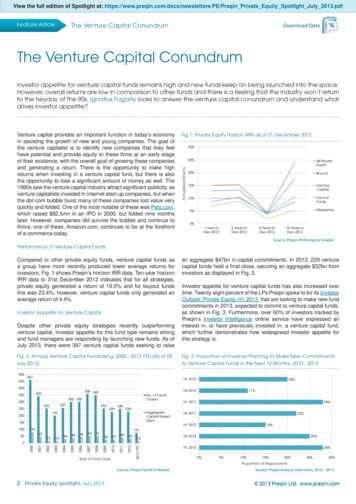
Transcription
Data is thenew capital
Executive SummaryBusinesses have relied on human, financial and intellectualcapital to grow and compete over the last few centuries. Nowthere is a new form of capital—Data—which is as essential forbusinesses today to survive and thrive in the digital age.A recent report1 indicates that data-driven organizations are growing at an average ofmore than 30% annually. The prescription for transforming into a data-driven companyrequires the development and adoption of an enterprise-wide data and analytics strategy,investment in a data platform, data governance and management processes and aculture that promotes data literacy and engagement.Data is the new capital2
A CEO Takes Chargewith Data CapitalThree years ago, McDonalds was coming off one of its worst yearsin decades as competitors had used online delivery to leapfrog thefast-food company’s lock on easy access.McDonalds’ CEO immediately drove an online delivery solution through a globalpartnership with UberEATS that by 2019 was adding 4 billion in annual sales.But McDonalds’ CEO knew that the long-term fix lay in a rapid and completetransformation of the company to become data driven. For McDonalds, that meanta strategy to reconfigure its restaurants into enormous data processors, completewith machine learning and mobile technology to support highly personalizedcustomer orders and curbside delivery. Also, calculating and responding to theimpact of external events from weather to big sporting matches on the customer,and to ensure that the development of new products and initiatives are immediatelysuccessful. While still a work in progress, the data transformation has alreadyachieved financial results: few companies in the S&P 500 have outperformedMcDonalds’ returns since 2015 and the company is posting higher sales gains.McDonalds has acquired or invested in several technology companies tofurther accelerate its transformation going forward.Data is the new capitalWhat McDonalds’ CEO did was to recognize that data was valuable, untapped capitalthat needed to be used strategically and holistically to ensure McDonalds could notonly survive but thrive. This is something that digitally-native companies born out ofdata such as Facebook, Google or sector-reinvention businesses like Uber or Amazonalready know. They are not only forcing the traditional firms to adopt data andanalytics to rethink their businesses, but also have spawned new ideas to transformexisting methods and processes such as real-time fraud detection for credit cardsor precision medicine in pharmaceuticals. The new data capital is used to trainartificial intelligence algorithms to enable innovation, resulting in financial gains andcustomer excellence.Read the full story on Accenture.com3
Accenture foresees a day in the not too distant futurewhen data will be an asset reported and accountedfor in a company’s balance sheet and reflected in itsmarket cap.This means that every CEO must be as strategic about acquiring, growing,refining, safeguarding and deploying their data as they are with their human,financial and intellectual capital.While data capital is subject to the magic of compounding returns, it must bemanaged. Just like borrowed financial capital can be a liability, acquired datathat is unconsented can present customer trust issues. The same diligencethat is brought to talent acquisition and training needs to be applied to dataacquisition and refinement. CEOs know to safeguard human, financial andintellectual capital and the same is true for data—a data breach can meanlawsuits, but importantly, loss of reputation and trust which is the new businesscurrency in this post-digital era. In short, if data is our new capital, trust is ournew currency.Data is the new capital84%Percentage of the market valueof S&P 500 companies thatcomes from intangible assets,including data and software24
Data Capital in YOUR IndustryWhile most industries are information-intensive and CEOs understand theimportance of data, few have truly committed to harnessing the power of data at astrategic level. Yet, companies are challenged with everything from rising customerand patient expectations for seamless care and digital services, diminishing ROI andcompetition from emerging players to increased regulation, pricing pressures andglobal disruptions to operations and supply chains. This is a true inflection point.CEOs who see data as capital can grow and ultimately reinventtheir businesses to be data- driven. But the stakes are evenhigher. There is the profound opportunity to use data capital tomanage profitability, improve ROI, maximize efficiencies, reducemanufacturing costs, create new products and services, improvecustomer satisfaction, enhance brand loyalty, help meet regulatoryrequirements, achieve compliance and ultimately improve lives.Accelerate your intelligent data journeyAlready there are promisingexamples of data-driven successesacross industries: Efficient supply chains and optimal inventory management is beingenabled by the creation of a robust master data management program. Decreased clinical trial timelines have been achieved through the use ofdata, analytics and automation innovations that accelerate study startup and patient recruitment, eliminate manual processes and expediteregulatory filings while decreasing cost for life sciences companies.5
The successful integration of data at scale from multiple sources,across product lines, portfolios and geographies using AI andmachine learning is helping global banks create an “analyticssupply chain” to discover insights for cross-selling opportunitiesand growth of new revenue streams. Analytics is creating value from data to predict and avoidexpensive events such as unplanned plant maintenance andoperation interruptions, and to mitigate or eliminate unsafeconditions. ProviderDirectories built using blockchain help minimize or avoiddiscrepancies in demographic details of healthcare providers.This solution acts as a trusted platform for collaboration and a“single source of truth” in maintaining the latest and accurateinformation. Integrated billing, sales and customer service systems givesenergy companies data-driven insights to understand whatcustomers to target through dynamic segmentation and enhanceexisting customer experience as never before.Nonetheless, according to an Accenture survey of 190 executivesin the US, 81% of companies lack an enterprise data strategy tofully capitalize on their data assets.3 While several CEOs havecommunicated their strategic intent to become data driven,most are struggling to define what that really means and moreimportantly how to get there.Data is the new capital6
A CEO PrescriptionTo help CEOs move from stated intention to activatingdata transformation, Accenture has created a prescriptiveapproach for creating and deploying data capital.Data is the new capital7
1. Enterprise-wideData & Analytics StrategyCorporations need to develop an enterprise- wide strategythat is linked to every aspect of the business.It needs to be aligned to LOB/divisional strategies and informed by the overall ITStrategy. However, the data strategy should also be considered a cornerstone whichenables future business strategies, with optimized investments in technology, peopleand processes. For example, a business looking to grow through acquisition shouldprioritize investment in building standardized data interfaces rather than analytics. Thedata strategy should also answer questions about the operating model for the dataand analytics functions. The strategy should also determine the right balance betweendefensive, offensive and monetization uses of data. In an industry that is heavilyregulated, the strategy must balance the offense of new product R&D and customerengagement with the defense of regulatory compliance and data protection.The journey is more important than the destination when it comes to data strategy. Theact of developing a data strategy in itself is educational as it generates cultural supportand alignment, a growth mindset, and new business ideas and priorities.Do you have a Data & Analytics Strategy?28%72%Have a dataanalytics strategyNo data analyticsstrategyHaving data by itself is not sufficient. If you get the dataand it just sits there, that’s not going to help you. Or if you use itin old-style decision-making, that’s not going to help. You need torethink your business processes about how you make decisions.Erik Brynjolfsson, Director,MIT Initiative on the Digital EconomyData is the new capital8
2. Data & Analytics CapabilityThe most important investment a company should considermaking is in building a Data and Analytics Platform.How effective is your Data Foundation?16%The data and analytics platform serves up connected and contextual data across theenterprise which leads to more informed answers and greater insights.The platform should be foundational and enterprise-wide to allow for interoperability ofcross-functional data to maximize power. Data and analytics environments have evolvedfrom the first generation of data warehouses for securing critical data to the secondgeneration of data lakes used store vast amounts of data to the current wave of platformsthat are being engineered to process and analyze data from machines, sensors anddevices at the speed of light. These platforms can create analytics reports, train artificialintelligence or machine learning models to hone predictive capabilities or be used foroperational applications and can convert data for easy consumption and enable agile dataprocessing.84%Able to serve data tobusiness at speedLacking the rightdata foundationThe data and analytics platform is centrally architected, based on cloud-basedinfrastructure to enable secure and scalable storage, processing and delivery of data aswell as mechanisms to organize, integrate, share and democratize data for consumption.The platforms are built for speed and adaptability, enabling the processing of complex,data-driven insights in real-time. The platform is comprised of numerous capabilities toenable the entire data and analytics ecosystem.Data is the new capital9
3. Data Governance & ManagementTrust in data is one of the biggest reasons why there is a gapbetween the promise and reality of analytics investments.Do you trust your data?33%rust in data is engendered by ensuring not only its quality but also its veracity which isderived from the provenance, lineage and virality of dataData quality requires stewardship and governance processes that come from a bottom-upapproach that includes data citizenship, self-help tools, clear governance around accessand firewall protections. In addition, there are advances in technology that are making iteasier to catalog and understand data, increasing its trustworthiness. If, in concert withits data strategy, a company develops clear data management and governance policiesand approaches, and a transparent stature with stakeholders, it can use trust as a criticaldifferentiator.Data is the new capital67%Only a third trusttheir data to derivevalue from itTwo thirds lacktrust in their data10
4. Data Culture and LiteracyIn an Accenture/Qlik study of 9,000 full time employees, only25% feel fully prepared to use data effectively and just 21% reportconfidence in their data literacy skills.The saying goes that ‘culture eats strategy for breakfast’ and that is true when executing a data andanalytics strategy.25%Percentage of employeesthat feel fully preparedto use data effectively21%Percentage of employeesthat report confidence intheir data literacy skillsThe commitment to be a data-driven company must permeate throughout the organization. Butit must start with the CEO. It is vital for the board, the CEO and the top management of the firmto become data conversant, knowledgeable on how data can add value to the business and theircurrent data environment challenges and aligned around data direction.Additionally, there needs to be a data champion within the company with a seat at the table fordiscussions of company strategy, investments and key initiatives. Whether that’s a Chief DigitalOfficer, Chief Data Officer, Chief Analytics Officer or some other CXO, what’s critical is that the datachampion must be equally well-versed in business and technology. They should also be able tothink about offensive vs. defensive uses of data, have cross-functional knowledge and be respectedby their peers as a change agent.Finally, the entire company needs to become data literate—aware of what data can do to improvebusiness processes at the grassroots levels in the company and how to make it happen. There aretools and platforms that can drive data literacy and adoption throughout an organization, but if theculture creates resistance, then the data strategy will stall. Change management is critical. Take thecase of the algorithm that greatly improved predicting of clinical trial duration. Because an internalteam resisted change, it took a full year longer than it should have get into production.It is necessary to have a programmatic approach to managing change that results from thecommitment to use data as capital.Data is the new capital11
A Final ThoughtOnce the decision’s been made to be a data capital richcompany and a strategy is in hand, there are three ways todeploy that data strategy:Top downmandateBottom-upcoalitionOr by piggybacking amajor strategic initiativelike Digital or GDPRThere are pros and cons of each approach and what a CEO chooses depends on businesscontext, leadership talent and appetite for investments.Generally speaking, the least risky approach is to deploy a data strategy through enablementof a major initiative. However, the strategy may become highjacked by the specific needs ofthe initiative and its success limited by that initiative. The top-down mandate can succeed butmust be combined with other approaches. McDonalds’ pivot to be a data capital companycame from the top, but it was led by the competitive response initiative to create a deliverybusiness, and it required careful change management at the leadership level and throughoutthe employee base, as well as coalition building with franchisees.At Accenture, we believe in the power of data capital and know how to help companies put datato work as capital.business to grow and generate sustainable value.Accelerate intelligent data journey12
About the authorShail JainLead Global Data& Applied IntelligenceReferences1. Forrester Report “Forrester’s Insights-DrivenBusinesses Set The Pace For Global Growth,Oct. 2018”2. Ocean Tomo LLC, 2015 Intangible AssetMarket Value Study; The Wall Street Journal3. Accenture Research, Closing the DataValue Gap, 2019About AccentureAbout Accenture ResearchAccenture is a leading global professional servicescompany, providing a broad range of services and solutionsin strategy, consulting, digital, technology and operations.Combining unmatched experience and specializedskills across more than 40 industries and all businessfunctions—underpinned by the world’s largest deliverynetwork—Accenture works at the intersection of businessand technology to help clients improve their performanceand create sustainable value for their stakeholders. With505,000 people serving clients in more than 120 countries,Accenture drives innovation to improve the way the worldworks and lives.Accenture Research shapes trends and creates data driveninsights about the most pressing issues global organizationsface. Combining the power of innovative researchtechniques with a deep understanding of our clients’industries, our team of 300 researchers and analysts spans20 countries and publishes hundreds of reports, articles andpoints of view every year. Our thought-provoking research—supported by proprietary data and partnerships withleading organizations, such as MIT and Harvard—guides ourinnovations and allows us to transform theories and freshideas into real-world solutions for our clients.Visit us at www.accenture.comFor more information, visit www.accenture.com/research
The commitment to be a data-driven company must permeate throughout the organization. But it must start with the CEO. It is vital for the board, the CEO and the top management of the firm to become data conversant, knowledgeable on how data can add value to the business and their current data environment challenges and aligned around data .











